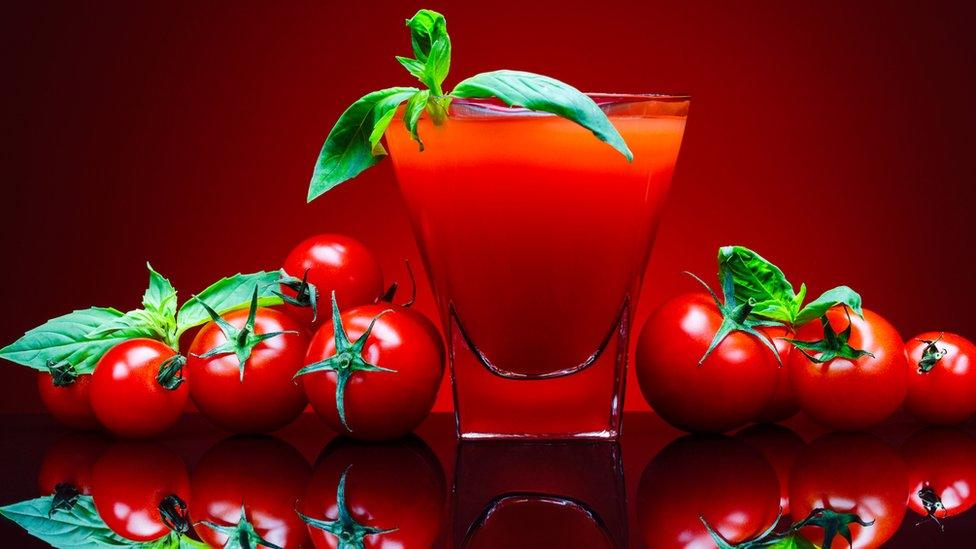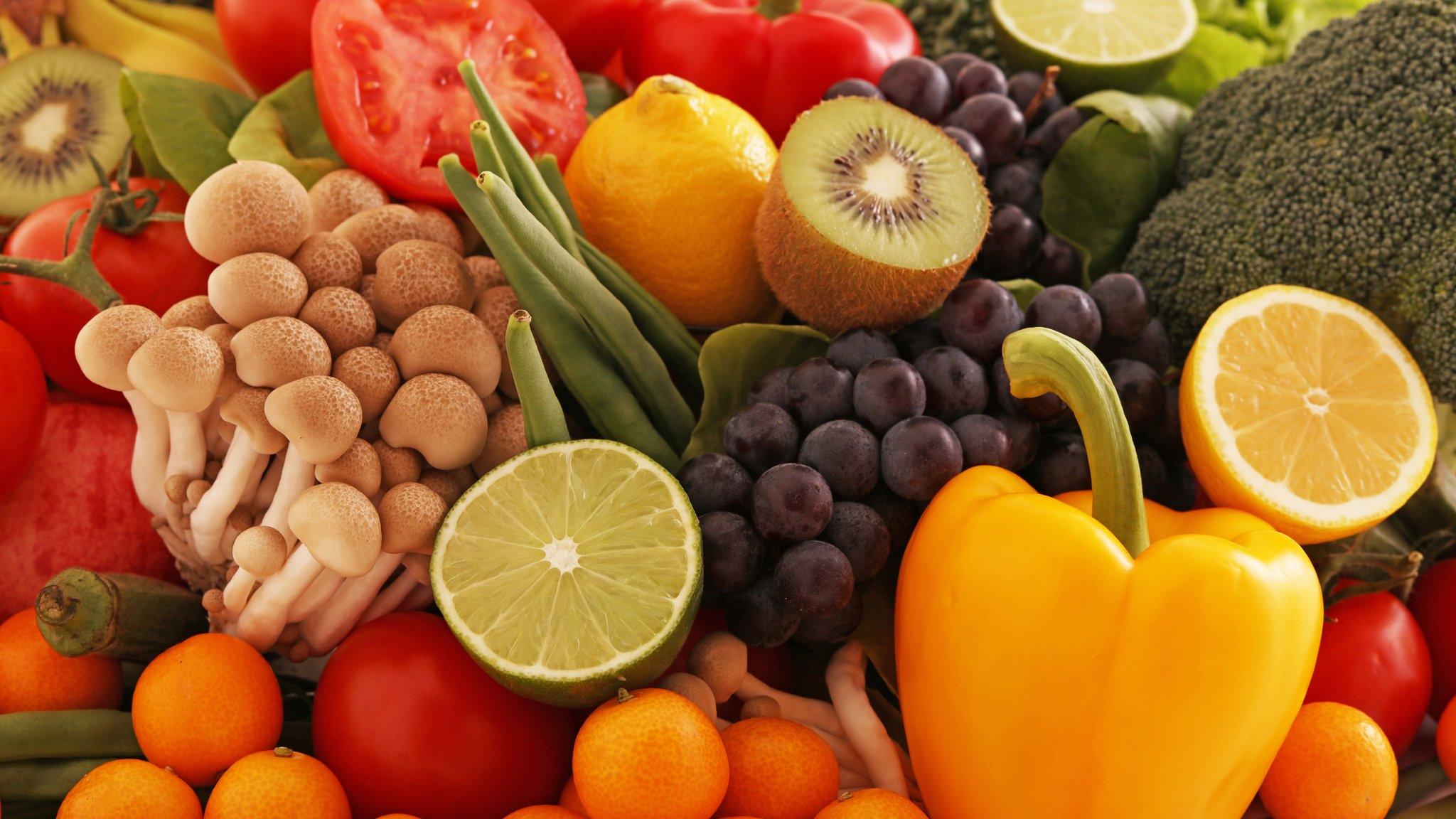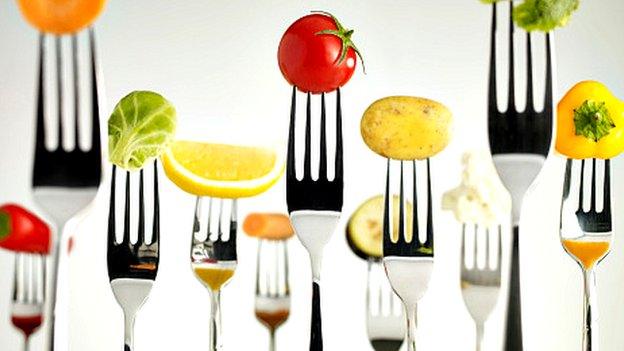Why tomato is the world's favoured fruit
- Published

Tomato - top fruit (?)
If you were asked to name the world's favourite fruit, the tomato may not be the one that comes to mind. But yes - it is a fruit, and yes - more tomatoes are produced globally than any other fruit. Here, Dr Michael Mosley explains the science behind its popularity.
Some people claim that the mango is the most popular fruit in the world, on the grounds that they are eaten in more countries than any other fruit.
From Asia to the Americas, people avidly consume them, not just as a sweet dessert, but in chutneys, ice cream and even cereal. They are certainly enormously popular in countries like India and China, with over 43m tonnes of mangoes being grown every year, external.
But if you measure popularity in terms of worldwide production, they are way behind the apple, and even further behind the banana.
There are over 100m tonnes of bananas produced every year, with India being the top producer.
For a longer life 'eat 10-a-day'
The chilling truth about ketchup
The secret of why we like chocolate
In the UK we eat more than five billion every year, most of which are a type called the Cavendish banana.
This was first cultivated and grown in Britain at Chatsworth house, an English stately home in the Peak District, by head gardener Joseph Paxton.
He named them Musa cavendishii, after his employers, the Cavendishes. Cavendish bananas are still grown in hothouses on the estate and eaten by the owners and their guests.
But dwarfing all other fruits is something we may not immediately think of as a fruit: the tomato.
'Beautiful - but poisonous'
Cooked or raw, as a sauce, a juice or a paste, the tomato is incredibly popular. With at least 170m tonnes of tomatoes being produced every year, the tomato tops even the mighty banana.
Most people think of the tomato as a vegetable, but technically it is a fruit because it has seeds, which puts it in the same botanical class as a berry.
Tomatoes were first introduced to Europe by the Spanish, who brought them back from the Americas.
The Aztecs, who cultivated and grew them, called them tomatl. This gave rise to the Spanish word "tomate", from which we get the English word tomato.

Tomato facts
There are more than 20,000 different varieties
La Tomatina takes place every year in the small Spanish town of Buñol. During the festival at least 40,000 people pelt each other with tomatoes
According to Guinness World Records, external, the largest tomato ever grown weighed in at 3.96kg on 30 August 2016.

La Tomatina is called the "biggest food fight in the world"

There was, initially, considerable resistance to eating tomatoes in Britain.
One of the first people to grow them was a 16th Century barber-surgeon called John Gerard. His book, Gerard's Herbal, describes them as beautiful but poisonous.
These days, of course, tomatoes are seen as a healthy food choice.
They are low in calories and rich in vitamin C, potassium, folate and vitamin K.
They also contain lots of a powerful antioxidant called lycopene, which has been linked to a number of health benefits, including reducing the risk of heart disease and some cancers. There is even some evidence that consuming tomato paste (which is particularly rich in lycopenes) can protect your skin against sunburn.
Earthy and meaty
But it's not the lycopene content that tickles our taste buds. It's the fact that they have a strong umami flavour.
Umami is a Japanese word that translates as "pleasant savoury taste". It is one of only five tastes that our tongues can detect. The others are bitter, sour, sweet and salty.
Umami is hard to describe, but you know it when you experience it.
It is an earthy flavour that you are more likely to associate with meat than a fruit.
If you add umami flavouring to something like soup, it makes the soup taste thicker, more substantial.
Lots of foods have a umami component, including, surprisingly, human breast milk. But the fruit that is richest in umami is the tomato.

For my new BBC2 series, The Secrets of Your Food, I decided to extract the pure umami flavour from tomatoes by chopping some up, then spinning them in a centrifuge.
I then filtered out the obvious lumps and simmered what remained to concentrate the taste. I was left with a clear fluid that no longer smelt "tomatoey" at all.
Instead it tasted salty, earthy, meaty. What my tongue sensed when I sipped that fluid was a substance called glutamate.
Glutamate is an amino acid, one of the building blocks of protein. And protein is essential to the building and running of every cell in our bodies.
Whenever you eat a food that contains glutamate, the glutamate molecules in the food trigger special receptors on your tongue. This then sends a signal to your brain which registers that taste as being "umami".
So, when you bite into a tomato or savour the taste of tomato paste on your pizza, what your taste buds are really doing is telling you is to eat this food because it is rich in glutamate, which will help keep you healthy and strong.
And that, I think, helps explain the tomato's universal popularity.
The Secrets of Your Food continues on BBC2 at 2100GMT on Friday 3rd March .
Join the conversation on our Facebook page, external.
- Published8 February 2017

- Published23 February 2017

- Published25 May 2016

- Published24 May 2016

- Published29 June 2013
